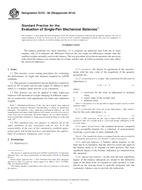We need your consent to use the individual data so that you can see information about your interests, among other things. Click "OK" to give your consent.
ASTM E319-85(2014)
Standard Practice for the Evaluation of Single-Pan Mechanical Balances (Withdrawn 2021)
Automatically translated name:
Standard Practice for the Evaluation of Single-Pan Mechanical Balances
STANDARD published on 1.11.2014
The information about the standard:
Designation standards: ASTM E319-85(2014)
Note: WITHDRAWN
Publication date standards: 1.11.2014
SKU: NS-46396
The number of pages: 9
Approximate weight : 27 g (0.06 lbs)
Country: American technical standard
Category: Technical standards ASTM
The category - similar standards:
Annotation of standard text ASTM E319-85(2014) :
Keywords:
balances, scales, weighing instruments ,, ICS Number Code 17.100 (Measurement of force, weight and pressure)
Additional information
| Significance and Use |
|
4.1 Monitoring Weighing Performance—This practice provides results in the form of control charts which measure the weighing capability at the time of the test. A series of tests at appropriate intervals will monitor balance performance over a period of time. A marked change from expected performance may result from a variety of causes including: maladjustment, damage, dirt, foreign material, and thermal disturbances. If the test results are to indicate future performance, any disturbances that occur exterior to the balance must be brought under control 4.2 Acceptance Tests—This practice may also be used as acceptance tests for new balances. For this purpose, the tests should be conducted under favorable, but not necessarily ideal, conditions. Since systematic error in the course of the zero and the course of the sensitivity may be caused by disturbances external to the balance, limits on these errors are not ordinarily prescribed in acceptance requirements. |
| 1. Scope |
|
1.1 This practice covers testing procedures for evaluating the performance of single-arm balances required by ASTM standards. 1.2 This practice is intended for but not limited to sensitivity ratios of 106 or better and on-scale ranges of 1000xd or more where d = reability either directly or by estimation. 1.3 This practice can also be applied to other single-pan balances with mechanical weight changing of different capacities or sensitivities with appropriate test loads and calibration weights. Note 1: Mechanical balances of this type have largely been
replaced by automatic electronic balances incorporating a variety
of operational principles. Nevertheless, some single-pan mechanical
balances are still manufactured and many older balances will remain
in service for years to come. One type of automatic electronic
balance, the so-called “hybrid,” bears considerable similarity to
single-pan mechanical balances of the null type. (1)2
1.4 This standard does not purport to address all of the safety problems, if any, associated with its use. It is the responsibility of the user of this standard to establish appropriate safety and health practices and determine the applicability of regulatory limitations prior to use. |
We recommend:
Technical standards updating
Do you want to make sure you use only the valid technical standards?
We can offer you a solution which will provide you a monthly overview concerning the updating of standards which you use.
Would you like to know more? Look at this page.




 Cookies
Cookies
